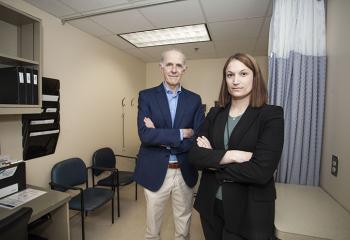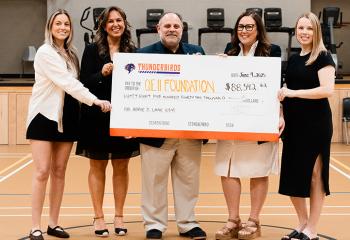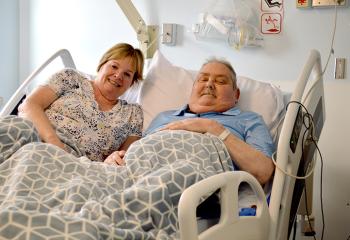
For the past 35 years, a group of about 40 physicians from the QEII’s Diagnostic Imaging (DI) department — some of whom are shown in this 2024 photo — have donated more than $2 million to the QEII Foundation to help fund a variety of projects that have revolutionized patient care within its interventional radiology (IR) and nuclear medicine divisions. QEII FOUNDATION
QEII Diagnostic Imaging physicians' donations making a difference
A group of about 40 physicians from the QEII Health Sciences Centre’s Diagnostic Imaging (DI) department have donated more than $2 million to the QEII Foundation.
These donations have come during the past 35 years to help fund a variety of projects that have revolutionized patient care within its interventional radiology (IR) and nuclear medicine divisions.
Dr. David Barnes, a nuclear medicine physician and former chief of the Department of Diagnostic Imaging at the QEII, says leadership has long recognized the QEII Foundation is key to making things happen at the QEII, particularly when it comes to advancing cutting-edge care.
He says the Foundation strives to make the QEII a leader in medical care, which is exactly what members of the DI department want to do.
“Our goals are the same. We want to provide excellent care that’s at the leading edge and so does the Foundation. For those reasons, we’re quite close to the mission of the Foundation. So, it’s our job to support the foundation because they support us.”
He says patients have ultimately benefited from the projects made possible by the group’s support of the QEII over the years, especially the purchase of the original PET-CT scan and a world-class advanced replacement a couple years ago.
The Foundation also supported the costly Gallium project, which Dr. Barnes says is very important for assessing people with neuroendocrine tumours for potential therapy. The project has also allowed for the launch of the PSMA PET program to help detect prostate cancer using many of the same original resources.
“The Foundation has been instrumental in making a lot of things happen here and has led the way for everyone to provide high-quality care for patients that we otherwise might not be able to do.”
Dr. Katie Eddy says she has witnessed the evolution of diagnostic imaging throughout her 11 years at the QEII. This includes the addition of a new diagnostic nuclear medicine SPECT-CT camera called StarGuide, which not only provides higher quality images, but acquires them faster to allow more patients to be scanned to better serve the growing Maritime population.
“The StarGuide camera was technically the first installed in Canada, which is significant for a centre of our size. It’s an amazing innovation to be a part of because it enhances the quality of the nuclear medicine imaging we do, which directly benefits our patients,” adds the clinical radiologist and nuclear medicine physician.
She says it also incentivizes the QEII as a training facility for medical residents and technologists who want experience using the newest and best equipment.
According to interventional radiologist Dr. Robert Berry, for many years the DI department has been cognizant of the fact that technology is expensive and if they’re going to ask people and the Foundation to support getting new equipment and technology for patients, they need to step up and do their part.
Although the group has worked with the Foundation on a number of exciting projects throughout the years, a real groundbreaker for him — because of its importance to cancer patients — was the PET-CT scanner.
“That is so fundamental and has such an impact on treatment decision-making for cancer patients. The Foundation really came through for us when it came to replacing that to make sure that we got the state-of-the-art, fastest machine so we could scan as many patients as we could to try to decrease the wait list and help as many people as we could.”
The Foundation also funded a CT scanner specifically for IR at the QEII’s Victoria General site.
“We were one of the first IR divisions in Canada to have our own CT scanner for procedures because of the Foundation,” shares Dr. Barnes.
The group of physicians has also partnered with the QEII Foundation to contribute matching gifts to three separate projects as part of the We Are campaign, including the purchase of state-of-the-art equipment for two of the four procedure rooms in the QEII’s new IR suite at the Halifax Infirmary site.
"The DI group recognized it was critical for us to do a matching fund campaign and the Foundation raised money for that and incredibly quickly had the equipment up and running.’’
The team’s dedication doesn’t go unnoticed. The QEII Foundation continues to be inspired by the diagnostic imaging physicians’ generosity and commitment to advancing care for patients.
“These folks are working long hours, delivering expert care,” says Susan Mullin, QEII Foundation president and CEO. “They believe in the care they’re providing — and the technology that helps them do so — and they’re putting their own funds forward to make it happen, impacting the lives of thousands of Nova Scotians every year.”


